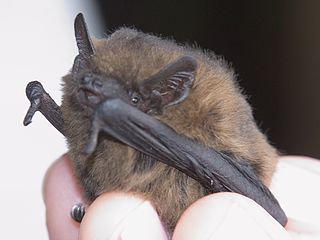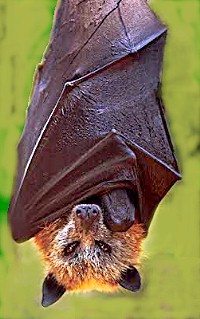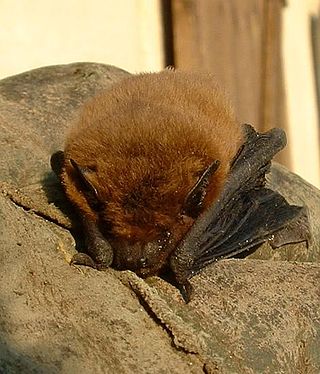
Vespertilionidae is a family of microbats, of the order Chiroptera, flying, insect-eating mammals variously described as the common, vesper, or simple nosed bats. The vespertilionid family is the most diverse and widely distributed of bat families, specialised in many forms to occupy a range of habitats and ecological circumstances, and it is frequently observed or the subject of research. The facial features of the species are often simple, as they mainly rely on vocally emitted echolocation. The tails of the species are enclosed by the lower flight membranes between the legs. Over 300 species are distributed all over the world, on every continent except Antarctica. It owes its name to the genus Vespertilio, which takes its name from a word for bat, vespertilio, derived from the Latin term vesper meaning 'evening'; they are termed "evening bats" and were once referred to as "evening birds".

The parti-coloured bat or rearmouse is a species of vesper bat that lives in temperate Eurasia, from Western and Southern Europe, eastwards over the Caucasus and Iran into Mongolia, north-east China, Korea, Afghanistan and northern Pakistan.

The common pipistrelle is a small pipistrelle microbat whose very large range extends across most of Europe, North Africa, South Asia, and may extend into Korea. It is one of the most common bat species in the British Isles. In Europe, the northernmost confirmed records are from southern Finland near 60°N.

The eastern red bat is a species of microbat in the family Vespertilionidae. Eastern red bats are widespread across eastern North America, with additional records in Bermuda.

The Indian flying fox, also known as the greater Indian fruit bat, is a species of flying fox native to the Indian subcontinent. It is one of the largest bats in the world. It is of interest as a disease vector, as it is capable of transmitting several viruses to humans. It is nocturnal and feeds mainly on ripe fruits, such as mangoes and bananas, and nectar. This species is often regarded as vermin due to its destructive tendencies towards fruit farms, but the benefits of its pollination and seed propagation often outweigh the impacts of its fruit consumption.

The Yinpterochiroptera is a suborder of the Chiroptera, which includes taxa formerly known as megabats and five of the microbat families: Rhinopomatidae, Rhinolophidae, Hipposideridae, Craseonycteridae, and Megadermatidae. This suborder is primarily based on molecular genetics data. This proposal challenged the traditional view that megabats and microbats form monophyletic groups of bats. Further studies are being conducted, using both molecular and morphological cladistic methodology, to assess its merit.

Yangochiroptera, or Vespertilioniformes, is a suborder of Chiroptera that includes most of the microbat families, except the Rhinopomatidae, Rhinolophidae, Hipposideridae, and Megadermatidae. These other families, plus the megabats, are seen as part of another suborder, the Yinpterochiroptera. All bats in Yangochiroptera use laryngeal echolocation(LE), which involves the use of high-frequency sounds to detect prey and avoid obstacles.

Nyctophilus is a genus of the vespertilionids or vesper bats. They are often termed Australian big-eared bats or long-eared bats, as the length of their ears often greatly exceeds that of the head. This genus occurs in the New Guinean-Australian region.

Antrozoini is a tribe of bats in the subfamily Vespertilioninae of the family Vespertilionidae. It contains the pallid bat, Van Gelder's bat, the genus Rhogeessa, and the fossil Anzanycteris. All species in this tribe are found in the Americas.

The meridional serotine is a species of bat native to the Iberian Peninsula, Morocco, Algeria, Tunisia and Libya.

Vespertilionini is a tribe of bats in the family Vespertilionidae. The largest of the tribes in Vespertilioninae, it contains many genera found throughout the Old World and Australasia.











